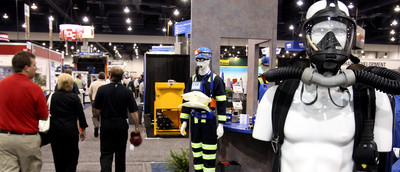DIGGING FOR WORKERS
Mention employee theft, and most business executives picture workers stealing office supplies or skimming the cash register.
For mining executive Bill McClure, vice president of human resources at Baltimore-based Foundation Coal Corp., employee theft means something else altogether: It refers to competitors who park outside Foundation's gates to recruit his employees. As if that's not subtle enough, rivals send up airplanes trailing banner ads exhorting Foundation's workers to decamp for other operations. The struggle for miners has intensified so much that Foundation, which operates in West Virginia and Wyoming, boosted wages $6 an hour from January through August.
McClure and other miners led a panel Wednesday at the MINExpo 2008 trade show inside the Las Vegas Convention Center to discuss personnel matters. Their basic message: The world has more productive mines than it has workers to staff them. That imbalance could translate into opportunities for workers from all sectors, and it will force companies to upgrade their recruiting efforts, experts said.
Unemployment levels have jumped across Nevada and the nation in recent months, but the mining sector hasn't felt the pain. State economists don't track jobless rates in the Silver State's mines, but a glance at regional unemployment provides a glimpse into how mining is faring. Nevada's unemployment hit a 15-year high of 7.1 percent in August, noted Bill Anderson, chief economist with the state's Department of Employment, Training & Rehabilitation, while joblessness in mining-intensive Elko County registered 4 percent.
For an idea of just how short-staffed mining is, consider mining specialists such as engineers and geologists. The United States needs 350 new mining specialists annually in the next decade, but the country's 13 mining colleges are turning out just 130 or so each year, said Leigh Freeman, general manager of Denver recruiting firm Downing Teal. That ratio likely won't improve, because mining professors are retiring at brisk rates.
"There'll be no one there to teach the next generation," Freeman said.
It's a global problem as well. An 80,000-worker shortage in positions ranging from truck drivers to mining specialists is keeping Australia's mines from fulfilling billions of dollars in commodities sales to China, Freeman said. Australia loosened its immigration policies to help deal with the understaffing.
Demographics and reputation have conspired to pare the mining work force.
Average age among mining workers surpasses 50, noted Rebecca Boam, assistant superintendent of human resources for mining company BHP Billiton in Farmington, N.M. As baby boomers retire, few younger workers are stepping up to replace them.
Blame kids' perception of the industry, Boam said.
For one thing, they believe mining is dangerous -- a notion that recent, high-profile accidents in West Virginia and Utah might have stoked. They also assume mining involves loads of hard, physical labor and little advanced technology.
"People literally think we still use picks and shovels," Boam said.
High schoolers also view mining as a job rather than a career path with lifelong employment opportunities, Boam said.
Miners are tackling the labor shortage from several angles.
Foundation holds job fairs every weekend.
"Sometimes we get just one person a weekend, but that's a success for us," McClure said. "That's how thin it is out there."
Foundation also attends high school career fairs to pique interest among students who don't plan to attend college. Executives have developed relationships with mining schools, and they're running radio ads and recruiting in regions with especially high unemployment. They give $1,000 to $3,000 to any employee who recommends a worker who stays on more than six months, and they've added benefits including relocation assistance, gym memberships and signing bonuses.
To retain workers, Foundation shells out bonuses for safety, production and performance, and the company pays a quarterly coal bonus based on high coal prices. Managers survey employees anonymously to pinpoint feelings about the workplace. They assemble teams of workers to help decide on promotions. And they cover tuition expenses for employees as well. They paid $75,000 for a worker to obtain his master's degree, though the employee left a month after he got his diploma.
At BHP Billiton, where workers enjoy referral bonuses, relocation assistance and company trucks, executives aim to relieve shortages through long-term planning.
The company created career paths that allow older workers to transition into less-physical mentor roles, for example. It launched educational programs to teach schoolchildren that mining "is not a dirty industry, that it's lucrative and safe," Boam said.
BHP Billiton also offers mine tours to the general public to boost knowledge about mines. Also, its human-resources staff members ask job candidates who turn down offers why they opted out of working for BHP Billiton, so they can better target the concerns and priorities of the workers they recruit.
Freeman advocated an even broader attack on the shortage of miners.
Companies can help by donating funds to create fellowships at mining colleges and to finance scholarships for students. They should consider contributing dollars to mining-research programs, and they could contribute intellectual capital by sending some of their top workers into colleges as part-time lecturers.
"Ultimately, the crisis is (mining) faculty," Freeman said. "If you lose faculty, you lose programs, and then your ability to solve the problem is gone."
Contact reporter Jennifer Robison at jrobison@reviewjournal.com or 702-380-4512.


















